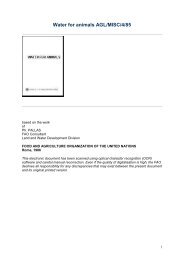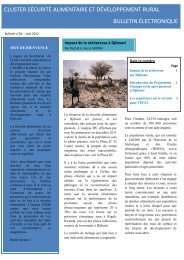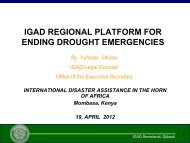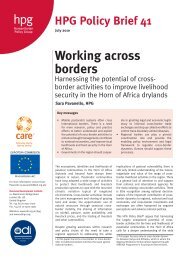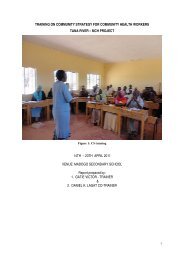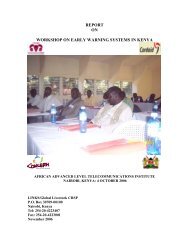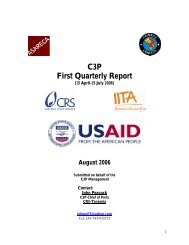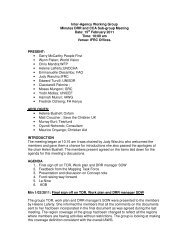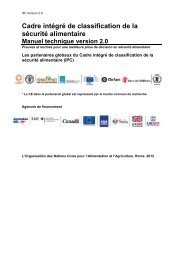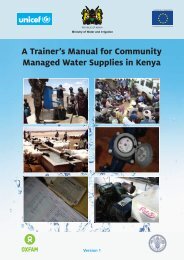4.2 Key observati<strong>on</strong>s in <strong>the</strong> water development sectorExamples highlighted in Secti<strong>on</strong> 3 indicate that positive changes are observed in terms <str<strong>on</strong>g>of</str<strong>on</strong>g> howpractiti<strong>on</strong>ers develop water in <strong>the</strong> dryl<str<strong>on</strong>g>and</str<strong>on</strong>g>s. Yet <strong>the</strong>se projects <str<strong>on</strong>g>and</str<strong>on</strong>g> programs by no means reflectoverall practice <str<strong>on</strong>g>and</str<strong>on</strong>g> more is needed to ensure that water points enhance ra<strong>the</strong>r than hinder pastorallivelihoods in <strong>the</strong> rangel<str<strong>on</strong>g>and</str<strong>on</strong>g>s.Extremely ambitious water development targets for water supply, as outlined by <strong>the</strong> UAP, <strong>the</strong>PASDEP <str<strong>on</strong>g>and</str<strong>on</strong>g> <strong>the</strong> WSDP (Secti<strong>on</strong> 3.2.2.4; p. 31), which are based in part <strong>on</strong> meeting MDG targets,are likely to see c<strong>on</strong>tinued heavy emphasis <strong>on</strong> infrastructure development at <strong>the</strong> expense <str<strong>on</strong>g>of</str<strong>on</strong>g>sustainability <str<strong>on</strong>g>and</str<strong>on</strong>g> appropriateness. Prioritizing buy-in as well as effective <str<strong>on</strong>g>and</str<strong>on</strong>g> representativeparticipati<strong>on</strong> by communities during planning would help implementers properly size <str<strong>on</strong>g>and</str<strong>on</strong>g> site waterpoints. Embedding <strong>the</strong> capacity to operate, manage <str<strong>on</strong>g>and</str<strong>on</strong>g> maintain water points locally would promotesustainability. Unless <strong>the</strong>se aspects are actively prioritized, <strong>the</strong> proliferati<strong>on</strong> <str<strong>on</strong>g>of</str<strong>on</strong>g> unsustainable <str<strong>on</strong>g>and</str<strong>on</strong>g>inappropriate water points is likely to c<strong>on</strong>tinue.Nati<strong>on</strong>al policies <str<strong>on</strong>g>and</str<strong>on</strong>g> strategies c<strong>on</strong>tinue to prioritize irrigati<strong>on</strong> <str<strong>on</strong>g>and</str<strong>on</strong>g> <strong>the</strong> expansi<strong>on</strong> <str<strong>on</strong>g>of</str<strong>on</strong>g> agriculture in<strong>the</strong> rangel<str<strong>on</strong>g>and</str<strong>on</strong>g>s as well as encourage <strong>the</strong> settlement <str<strong>on</strong>g>of</str<strong>on</strong>g> pastoralists in <strong>the</strong> l<strong>on</strong>g term. This posesc<strong>on</strong>siderable challenges to <strong>the</strong> resilience <str<strong>on</strong>g>of</str<strong>on</strong>g> livestock-based pastoral livelihoods <str<strong>on</strong>g>and</str<strong>on</strong>g> a new program isunderway to encourage a fairer, more balanced treatment <str<strong>on</strong>g>of</str<strong>on</strong>g> pastoralism as an importantc<strong>on</strong>tributor to development <str<strong>on</strong>g>and</str<strong>on</strong>g> to <strong>the</strong> ec<strong>on</strong>omy 53 . If government policy <str<strong>on</strong>g>and</str<strong>on</strong>g> strategy objectivesremain as <strong>the</strong>y are, l<str<strong>on</strong>g>and</str<strong>on</strong>g> available for grazing is likely to be reduced (especially key dry seas<strong>on</strong> grazingareas), pastoral access to rivers is likely to become fur<strong>the</strong>r obstructed exacerbating water problems,<str<strong>on</strong>g>and</str<strong>on</strong>g> mobility - an essential strategy used by pastoralists to avoid risk – will be fur<strong>the</strong>r undermined.Finding comm<strong>on</strong> ground between nati<strong>on</strong>al, regi<strong>on</strong>al, sub-regi<strong>on</strong>al <str<strong>on</strong>g>and</str<strong>on</strong>g> local priorities will be essentialto ensure that nati<strong>on</strong>al ec<strong>on</strong>omic growth can occur unimpeded but without compromisingsustainable development that resp<strong>on</strong>ds to local needs.4.2.1 Impacts <str<strong>on</strong>g>of</str<strong>on</strong>g> water developmentWater point development critically alleviates <strong>the</strong> stresses <str<strong>on</strong>g>of</str<strong>on</strong>g> serious water shortages <str<strong>on</strong>g>and</str<strong>on</strong>g> physicalaccess c<strong>on</strong>straints in Ethiopia’s arid areas. It allows access to important groundwater resourceswhere rainfall is too variable or poor to provide reliable surface water, <str<strong>on</strong>g>and</str<strong>on</strong>g> simple technologies likeh<str<strong>on</strong>g>and</str<strong>on</strong>g> dug wells al<strong>on</strong>g rivers provide communities with much-needed clean water.However, water development can trigger a slew <str<strong>on</strong>g>of</str<strong>on</strong>g> negative c<strong>on</strong>sequences if local needs, l<str<strong>on</strong>g>and</str<strong>on</strong>g> usepatterns <str<strong>on</strong>g>and</str<strong>on</strong>g> ecological functi<strong>on</strong>s are not sufficiently c<strong>on</strong>sidered. The ir<strong>on</strong>y is that as much as watercan alleviate immediate pressures in <strong>the</strong> short term, it can potentially bring with it lasting <str<strong>on</strong>g>and</str<strong>on</strong>g> seriousnegative impacts in <strong>the</strong> l<strong>on</strong>g term. This can undermine ra<strong>the</strong>r than promote development <str<strong>on</strong>g>and</str<strong>on</strong>g>sustainable livelihoods.To date, very little has been d<strong>on</strong>e to systematically track impacts <str<strong>on</strong>g>of</str<strong>on</strong>g> water development <strong>on</strong>livelihoods. Despite this, trial <str<strong>on</strong>g>and</str<strong>on</strong>g> error over many years in <strong>the</strong> field has created more awarenessam<strong>on</strong>g actors about <strong>the</strong> negative impacts <str<strong>on</strong>g>of</str<strong>on</strong>g> poorly planned water interventi<strong>on</strong>s, especially related tolarge capacity or permanent water points.Gomes (2007) captures well some c<strong>on</strong>sequences <str<strong>on</strong>g>and</str<strong>on</strong>g> impacts <str<strong>on</strong>g>of</str<strong>on</strong>g> such water interventi<strong>on</strong>s in nor<strong>the</strong>asternEthiopia, which include: settlement around water points, appearance <str<strong>on</strong>g>of</str<strong>on</strong>g> competing l<str<strong>on</strong>g>and</str<strong>on</strong>g> usessuch as agriculture in rangel<str<strong>on</strong>g>and</str<strong>on</strong>g> areas, o<strong>the</strong>r forms <str<strong>on</strong>g>of</str<strong>on</strong>g> privatizati<strong>on</strong> such as fencing porti<strong>on</strong>s <str<strong>on</strong>g>of</str<strong>on</strong>g> <strong>the</strong>rangel<str<strong>on</strong>g>and</str<strong>on</strong>g>s for private use (seen by some as an attempt to buffer <strong>the</strong> rangel<str<strong>on</strong>g>and</str<strong>on</strong>g>s against c<strong>on</strong>versi<strong>on</strong>for crop producti<strong>on</strong>), overc<strong>on</strong>centrati<strong>on</strong> <str<strong>on</strong>g>of</str<strong>on</strong>g> livestock around water points <str<strong>on</strong>g>and</str<strong>on</strong>g> range degradati<strong>on</strong>,53 Led by <strong>the</strong> Feinstein Internati<strong>on</strong>al Center (Tufts University) in partnership with <strong>the</strong> Internati<strong>on</strong>al Institutefor Envir<strong>on</strong>ment <str<strong>on</strong>g>and</str<strong>on</strong>g> Development (IIED) <str<strong>on</strong>g>and</str<strong>on</strong>g> targeting government partners <str<strong>on</strong>g>and</str<strong>on</strong>g> civil society up to 2011.72
excessive <str<strong>on</strong>g>and</str<strong>on</strong>g> unc<strong>on</strong>trolled use <str<strong>on</strong>g>of</str<strong>on</strong>g> water infrastructure leading to breakage <str<strong>on</strong>g>and</str<strong>on</strong>g> water shortages,deforestati<strong>on</strong> for charcoal producti<strong>on</strong>, reducti<strong>on</strong> <str<strong>on</strong>g>of</str<strong>on</strong>g> available palatable perennial grass, overabstracti<strong>on</strong><str<strong>on</strong>g>and</str<strong>on</strong>g> lowering <str<strong>on</strong>g>of</str<strong>on</strong>g> <strong>the</strong> water table, salinizati<strong>on</strong> <str<strong>on</strong>g>and</str<strong>on</strong>g> salt-water intrusi<strong>on</strong>, <str<strong>on</strong>g>and</str<strong>on</strong>g> c<strong>on</strong>flict over<strong>the</strong> c<strong>on</strong>trol <str<strong>on</strong>g>of</str<strong>on</strong>g> water points.In Ethiopia negative c<strong>on</strong>sequences related to size <str<strong>on</strong>g>and</str<strong>on</strong>g> capacity <str<strong>on</strong>g>of</str<strong>on</strong>g> water points have been identifiedby researchers since <strong>the</strong> 1980s, most notably since <strong>the</strong> Rangel<str<strong>on</strong>g>and</str<strong>on</strong>g> Development Project <str<strong>on</strong>g>of</str<strong>on</strong>g> <strong>the</strong> late1970s. However, this body <str<strong>on</strong>g>of</str<strong>on</strong>g> work is rarely used to inform development <str<strong>on</strong>g>and</str<strong>on</strong>g> relief projectprogramming. There are some notable <str<strong>on</strong>g>and</str<strong>on</strong>g> significant excepti<strong>on</strong>s however am<strong>on</strong>g government,d<strong>on</strong>ors <str<strong>on</strong>g>and</str<strong>on</strong>g> NGOs, who have recognized that large capacity or permanent water points encouragesettlements with associated reducti<strong>on</strong>s in mobility <str<strong>on</strong>g>and</str<strong>on</strong>g> rangel<str<strong>on</strong>g>and</str<strong>on</strong>g> quality. The GWI’s (Secti<strong>on</strong> 3.1.3.1;p. 47) recently developed Integrated Water Resource Management strategy for Borana z<strong>on</strong>ementi<strong>on</strong>s that permanent water points c<strong>on</strong>structed in <strong>the</strong> rangel<str<strong>on</strong>g>and</str<strong>on</strong>g>s are likely to affect mobility(such as deep wells <str<strong>on</strong>g>and</str<strong>on</strong>g> permanent p<strong>on</strong>ds 54 ) <str<strong>on</strong>g>and</str<strong>on</strong>g> are more c<strong>on</strong>tentious than those which extendwater availability for a few m<strong>on</strong>ths. It also menti<strong>on</strong>s that smaller capacity systems are less likely to beproblematic (Pankhurst, 2009; see table 5 in previous secti<strong>on</strong>s for fur<strong>the</strong>r informati<strong>on</strong>).Government programs also recognize <strong>the</strong> potential implicati<strong>on</strong>s <str<strong>on</strong>g>of</str<strong>on</strong>g> large or permanent water points.Highlights include:• The MoFA’s PCDP (Secti<strong>on</strong> 3.1.2.3: p.28), which highlights that smaller temporary watercatchments are more suitable in wet seas<strong>on</strong> grazing areas to avoid settlement <str<strong>on</strong>g>and</str<strong>on</strong>g> its associatedproblems. It also emphasizes <strong>the</strong> rehabilitati<strong>on</strong> <str<strong>on</strong>g>of</str<strong>on</strong>g> existing water points <str<strong>on</strong>g>and</str<strong>on</strong>g> enabling pastoralaccess to rivers in dry seas<strong>on</strong> grazing areas. This is to make <strong>the</strong> most <str<strong>on</strong>g>of</str<strong>on</strong>g> what is already <strong>the</strong>re<str<strong>on</strong>g>and</str<strong>on</strong>g> to sidestep altoge<strong>the</strong>r, where possible, any c<strong>on</strong>tentious issues that may arise from <strong>the</strong>c<strong>on</strong>structi<strong>on</strong> <str<strong>on</strong>g>of</str<strong>on</strong>g> new water points.• The MoWR’s WSSP (Secti<strong>on</strong> 3.1.2.3: p.33), which recognizes <strong>the</strong> negative impacts associatedwith large capacity water points in <strong>the</strong> rangel<str<strong>on</strong>g>and</str<strong>on</strong>g>s. It recommends that points not exceed a sizewhich waters a maximum <str<strong>on</strong>g>of</str<strong>on</strong>g> 4,500 cattle a day, <str<strong>on</strong>g>and</str<strong>on</strong>g> that points should be spaced about 20kmapart.• The government’s PSNP for pastoral areas (Secti<strong>on</strong> 3.1.2.3: p.39), which plans to c<strong>on</strong>structpublic works in <strong>the</strong> rangel<str<strong>on</strong>g>and</str<strong>on</strong>g>s in ways which do not interfere with mobility systems by ensuringclose collaborati<strong>on</strong> with pastoralists at <strong>the</strong> local level <str<strong>on</strong>g>and</str<strong>on</strong>g> c<strong>on</strong>textualizing developments withinlivelihood <str<strong>on</strong>g>and</str<strong>on</strong>g> l<str<strong>on</strong>g>and</str<strong>on</strong>g>scape z<strong>on</strong>es.A lesser acknowledged issue is that associated with birkado, especially in Somali regi<strong>on</strong>. Originallyintended as temporary water catchments, <strong>the</strong>se structures now tend to functi<strong>on</strong> as year-roundwater sources thanks to refilling via water tankering. Associated with this trend is <strong>the</strong> establishment<str<strong>on</strong>g>of</str<strong>on</strong>g> permanent settlements, which has seen some <str<strong>on</strong>g>of</str<strong>on</strong>g> <strong>the</strong> previously menti<strong>on</strong>ed impacts manifestedacross <strong>the</strong> regi<strong>on</strong>. Even though a lot <str<strong>on</strong>g>of</str<strong>on</strong>g> birkado c<strong>on</strong>structi<strong>on</strong> was (<str<strong>on</strong>g>and</str<strong>on</strong>g> is) instigated by pastoralists,pastoralists <strong>the</strong>mselves have become more aware <str<strong>on</strong>g>of</str<strong>on</strong>g> <strong>the</strong> negative impacts <str<strong>on</strong>g>of</str<strong>on</strong>g> this type <str<strong>on</strong>g>of</str<strong>on</strong>g> waterdevelopment <str<strong>on</strong>g>and</str<strong>on</strong>g> also vocal about ways to mitigate <strong>the</strong>m. Gomes (2007) notes that traditi<strong>on</strong>al xeeragreements 55 have emerged in parts <str<strong>on</strong>g>of</str<strong>on</strong>g> Somali regi<strong>on</strong> to limit <strong>the</strong> establishment <str<strong>on</strong>g>of</str<strong>on</strong>g> new watersources around existing settlements as well as in wet seas<strong>on</strong> grazing areas. These agreements54 Recently birkado have been added to this list, as <strong>the</strong>y functi<strong>on</strong> as year round water sources thanks toc<strong>on</strong>tinuous refilling via water trucking, especially prevalent in Somali regi<strong>on</strong> (Beruk Yemane, Oxfam GBPastoral Program Coordinator <str<strong>on</strong>g>and</str<strong>on</strong>g> Ced Hesse, IIED Principal Researcher, Climate Change Group, pers<strong>on</strong>alcommunicati<strong>on</strong>s)55 Traditi<strong>on</strong>al agreements between elders <str<strong>on</strong>g>of</str<strong>on</strong>g> structurally distant groups <strong>on</strong> <strong>the</strong> ethnic Somali genealogicalcharter (Gomes, 2007).73
- Page 1 and 2:
Synthesis
- Page 4 and 5:
TABLE OF CONTENTSLIST OF ACRONYMS..
- Page 6 and 7:
ACKNOWLEDGMENTSI would like to exte
- Page 8 and 9:
LIST OF ACRONYMSACDI/VOCAACFAFDCDDC
- Page 10 and 11:
EXECUTIVE SUMMARYWater development
- Page 12 and 13:
understanding <str
- Page 14 and 15:
Agreed upon guidelines for water de
- Page 16 and 17:
• Make better use of</str
- Page 18 and 19:
to inform their own work an
- Page 20 and 21:
Within pastoral areas, it is recogn
- Page 23 and 24: Section 2. Overview of</str
- Page 25 and 26: Dohrn, 2006). Spatially variable ra
- Page 27 and 28: The following broad overview touche
- Page 29 and 30: In areas of adequa
- Page 31 and 32: observed response was for individua
- Page 33 and 34: Specific to water development, seve
- Page 35 and 36: Section 3. Water development todayT
- Page 37 and 38: Eliciting payments for water from l
- Page 39 and 40: ureaus 25 . The ministry’s interv
- Page 41 and 42: National policy paints a conflictin
- Page 43 and 44: will be given to pastoralists to en
- Page 45 and 46: Water supplyGovernance and<
- Page 47 and 48: vulnerable to conversion for other
- Page 49 and 50: • Agro-pastoralists’ priorities
- Page 51 and 52: Although the WSDP principles are se
- Page 53 and 54: The Universal Access ProgramThe Uni
- Page 55 and 56: • Help ensure that public works d
- Page 57 and 58: However, the development model for
- Page 59 and 60: Figure 4: Proposed pilot la
- Page 61 and 62: Many international and</str
- Page 63 and 64: Furthermore, attention is given to
- Page 65 and 66: CARE International, under the GWI,
- Page 67: and traditional me
- Page 70 and 71: • Understand exi
- Page 74 and 75: epresent a firm attempt to preserve
- Page 76 and 77: learning from NGO experiences in Bo
- Page 78 and 79: However, there are currently no spe
- Page 80 and 81: 4.3 Conclusion, ways forward <stron
- Page 82 and 83: In sum, pastoralism as a livelihood
- Page 84 and 85: • Water interventions selected sh
- Page 86 and 87: • Promote effective participation
- Page 88 and 89: Gebre-Mariam, A. (1982). Organizati
- Page 90: Schimann P. and Ph



